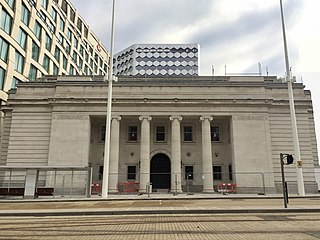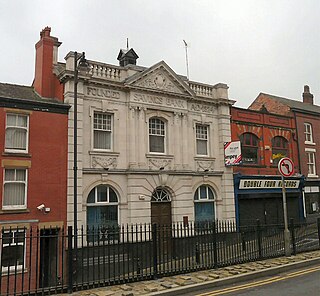
Lloyds Bank plc is a British retail and commercial bank with branches across England and Wales. It has traditionally been considered one of the "Big Four" clearing banks. Lloyds Bank is the largest retail bank in Britain, and has an extensive network of branches and ATMs in England and Wales and offers 24-hour telephone and online banking services. As of 2012 it had 16 million personal customers and small business accounts.

The Trustee Savings Bank (TSB) was a British financial institution. Trustee savings banks originated to accept savings deposits from those with moderate means. Their shares were not traded on the stock market but, unlike mutually held building societies, depositors had no voting rights; nor did they have the power to direct the financial and managerial goals of the organisation. Directors were appointed as trustees on a voluntary basis. The first trustee savings bank was established by Reverend Henry Duncan of Ruthwell in Dumfriesshire for his poorest parishioners in 1810, with its sole purpose being to serve the local people in the community. Between 1970 and 1985, the various trustee savings banks in the United Kingdom were amalgamated into a single institution named TSB Group plc, which was floated on the London Stock Exchange. In 1995, the TSB merged with Lloyds Bank to form Lloyds TSB, at that point the largest bank in the UK by market share and the second-largest by market capitalisation.

Trust Bank New Zealand Ltd was a registered bank that operated in New Zealand between 1986 and 1996. It was made up of the former regional savings banks that had their origins as far back as 1847. It was acquired by Westpac Bank in 1996 which phased out the Trust Bank brand at the end of 2002, when the bank was rebranded from WestpacTrust to simply Westpac.
TSB Bank Ltd trading as TSB, is a New Zealand bank with headquarters in New Plymouth. It has 25 branches across the country but is heavily focused on the Taranaki region where 12 of its branches are located.

Geoffrey Finsberg, Baron Finsberg, was a British Conservative politician. He was the Member of Parliament (MP) for Hampstead from 1970 to 1983, and for its successor constituency, Hampstead & Highgate, from 1983 to 1992.

The Birmingham Municipal Bank was a savings bank in the city of Birmingham, England. It was created as the Birmingham Corporation Savings Bank by a 1916 Act of Parliament on a temporary basis and replaced by the Birmingham Municipal Bank in 1919. In 1976 it converted into a trustee savings bank.

Lloyds Banking Group plc is a British financial institution formed through the acquisition of HBOS by Lloyds TSB in 2009. It is one of the UK's largest financial services organisations, with 30 million customers and 65,000 employees. Lloyds Bank was founded in 1765 but the wider Group's heritage extends over 320 years, dating back to the founding of the Bank of Scotland by the Parliament of Scotland in 1695.

Georg Fahrenschon is a German politician, representative of the Christian Social Union of Bavaria. From 2008 to 2011 he served as finance minister in the Bavarian State Ministry of Finance. He was a member of the Bundestag of Germany until 2007.

Eastern & Central Savings Bank was a savings bank that operated in New Zealand between 1972 and 1987. It was the result of a merger between two smaller regional savings banks; Hawke’s Bay and Gisborne Savings Bank and Manawatu Wairarapa Savings Bank. Fifteen years later it absorbed the customers of Trust Bank Wanganui to become Trust Bank Central.

TSB Bank plc is a retail and commercial bank in the United Kingdom and a subsidiary of Sabadell Group.
Formed in 1836, the Edinburgh Savings Bank was successor to the Edinburgh Bank for Savings, which dated back to 1814. Although formed after the Ruthwell Savings Bank, the Edinburgh provided the model for future savings banks. By the end of World War two, it was second in size only to the Glasgow Savings Bank. In 1975, Edinburgh merged with three other Scottish savings banks to form an enlarged South of Scotland TSB.
The Aberdeen Savings Bank is a Scottish savings bank. It was formed in 1815 and reconstituted in 1845 under the 1835 Savings Act. It remained a small bank until the interwar period when a series of acquisitions made it grow to fifth in size in 1944. It became one of Scotland's four regional savings banks in 1975. In 1983, it became a part of TSB Scotland.
The Glasgow Savings Bank, formed in 1836, had become the largest savings banks in Scotland by the mid-1850s and the largest in the country by 1870. When the trustee savings banks were reorganised into regional banks in 1975 Glasgow became the core of the West of Scotland TSB.

The Stockport Savings Bank was formed in 1824 in Stockport, then in the county of Cheshire. It was run on a conservative basis but remained independent until 1975 when it became part of TSB North West Central, following the Page Committee’s recommendation that the TSBs be grouped into larger regional entities.
The Sheffield Savings Bank was formed in Sheffield Yorkshire in 1819. For much of its early years it was run conservatively, briefly experimenting with local branches in the 1850s. In the twentieth century, branches were reintroduced, both in the city and outlying towns. By 1944 it was twelfth nationally by size of funds. In 1976, the Bank merged to form part of TSB Yorkshire & Lincoln.
The Perth Savings Bank was established in Perth, Scotland, in 1815. In 1975, it merged to form part of the Trustee Savings Bank of Tayside and Central Scotland.
The West Midland Savings Bank had its roots in Shrewsbury, Shropshire and the merger of its two town banks in 1839 to become the Salop County and Abbey Savings Bank. It remained one of many small savings banks in the Border Counties until the early twentieth century when it led a series of amalgamations. In recognition of its wider coverage, it became the West Midlands TSB in 1937. In 1975 it merged to form the TSB of Wales and Border Counties.
The Liverpool Savings Bank was a bank founded in 1815 in Liverpool, United Kingdom. By 1956, it had grown to be the fourth largest savings bank in the country. Following the 1975 TSB Act, the Bank became part of the TSB of Mid-Lancashire & Merseyside.
The Manchester and Salford Savings Bank opened in 1818 in Manchester. For a long period, it was the third largest savings bank in the country and at one stage, the largest savings bank in England. Following the Trustee Savings Bank Act of 1975, the Bank merged with seven other local savings banks to form the TSB North West Central.
The London Savings Bank was a product of a 1916 merger between the London Provident Institution (1816), the Bloomsbury Savings Bank (1817) and the Lambeth Savings Bank (1818). In 1942 the Finsbury and City of London Savings Bank amalgamated with the London Savings Bank. In 1971, the London Savings Bank became part of the London and South Eastern TSB, which in turn became part of TSB South East.








